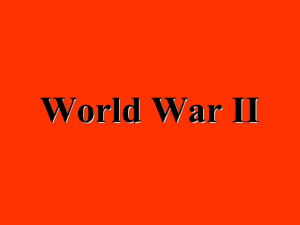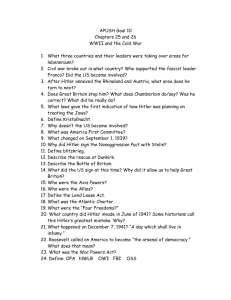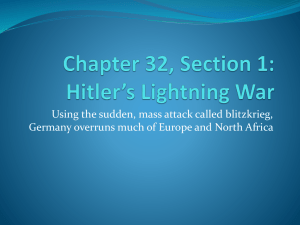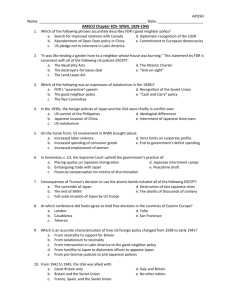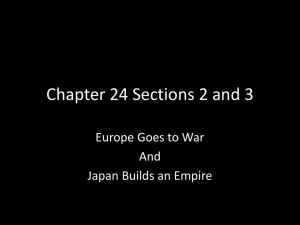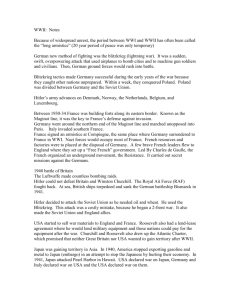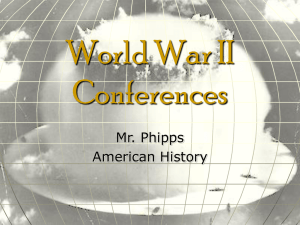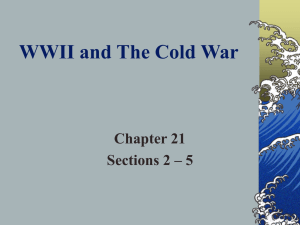WWII notes
advertisement
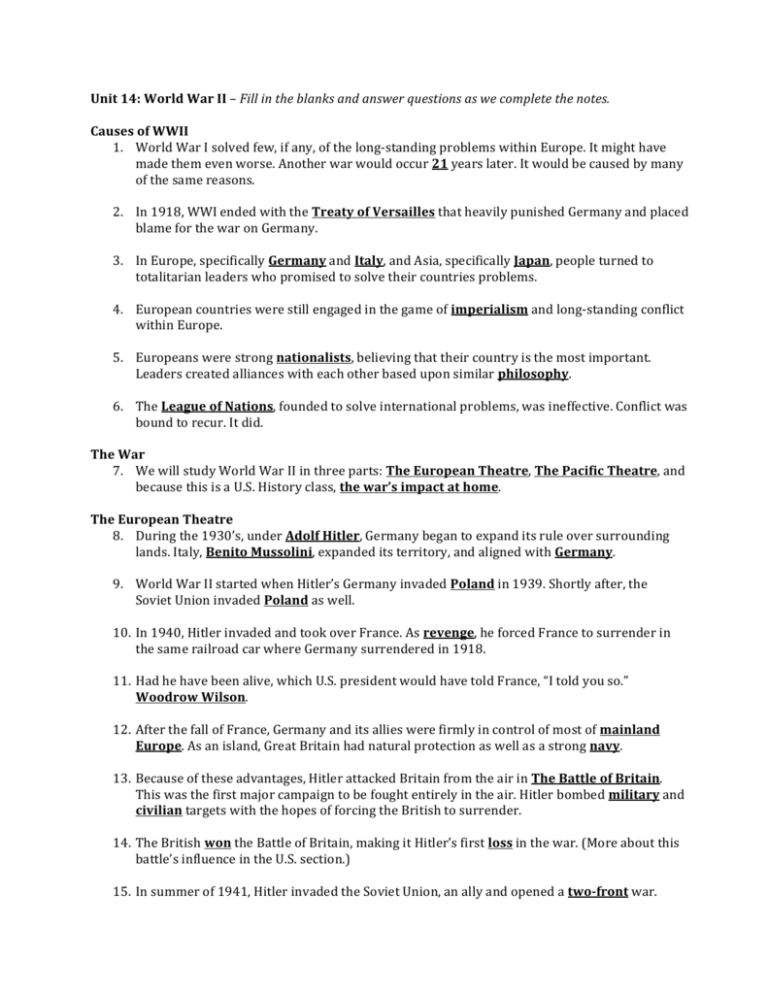
Unit 14: World War II – Fill in the blanks and answer questions as we complete the notes. Causes of WWII 1. World War I solved few, if any, of the long-­‐standing problems within Europe. It might have made them even worse. Another war would occur 21 years later. It would be caused by many of the same reasons. 2. In 1918, WWI ended with the Treaty of Versailles that heavily punished Germany and placed blame for the war on Germany. 3. In Europe, specifically Germany and Italy, and Asia, specifically Japan, people turned to totalitarian leaders who promised to solve their countries problems. 4. European countries were still engaged in the game of imperialism and long-­‐standing conflict within Europe. 5. Europeans were strong nationalists, believing that their country is the most important. Leaders created alliances with each other based upon similar philosophy. 6. The League of Nations, founded to solve international problems, was ineffective. Conflict was bound to recur. It did. The War 7. We will study World War II in three parts: The European Theatre, The Pacific Theatre, and because this is a U.S. History class, the war’s impact at home. The European Theatre 8. During the 1930’s, under Adolf Hitler, Germany began to expand its rule over surrounding lands. Italy, Benito Mussolini, expanded its territory, and aligned with Germany. 9. World War II started when Hitler’s Germany invaded Poland in 1939. Shortly after, the Soviet Union invaded Poland as well. 10. In 1940, Hitler invaded and took over France. As revenge, he forced France to surrender in the same railroad car where Germany surrendered in 1918. 11. Had he have been alive, which U.S. president would have told France, “I told you so.” Woodrow Wilson. 12. After the fall of France, Germany and its allies were firmly in control of most of mainland Europe. As an island, Great Britain had natural protection as well as a strong navy. 13. Because of these advantages, Hitler attacked Britain from the air in The Battle of Britain. This was the first major campaign to be fought entirely in the air. Hitler bombed military and civilian targets with the hopes of forcing the British to surrender. 14. The British won the Battle of Britain, making it Hitler’s first loss in the war. (More about this battle’s influence in the U.S. section.) 15. In summer of 1941, Hitler invaded the Soviet Union, an ally and opened a two-­front war. The Pacific Theatre 16. In the late 1800’s Japan industrialized and sought to be a world power. Other countries in East Asia and the Pacific did not. Japan sought to became the dominant military and economic power in East Asia. 17. Much like in Europe, Japan fought a series of wars in pursuit of natural resources. Japan increasingly looked to eliminate Western influences in East Asia. 18. In 1931, Japan invaded and took over Manchuria, the coastal area in northeast China between modern-­‐day Korea and Russia. This was part of Japanese imperialism-­‐ they wanted to dominate China and use its resources. 19. In 1937, Japan and China began a full-­‐scale war. Japan dominates China because of its more advanced technology. 20. During the rest of the 1930’s and early 1940’s, Japan expands its conquest in Asia and the Pacific. 21. To stop Japanese expansion, the United States, along with other nations issued an oil and steel embargo against Japan. Japan viewed this as a threat and as an act of aggression and prepared for war. The U.S. before 1941 22. After WWI, most Americans became isolationists again. They wanted to avoid another war. 23. As Germany and Japan expanded, the U.S. continued to take an isolationist position, though President Franklin D. Roosevelt grew increasingly concerned with the situation in Europe. 24. In 1939, the U.S. took a step away from neutrality when it started the “Cash and Carry” policy where the U.S. would sell supplies provided they were paid for in cash and not transported on American ships. 25. In 1941, after the Battle of Britain, recognizing that the goal of fascism was to destroy democratic ideals and that American security depended upon Great Britain acting as a buffer, Congress passed the “Lend-­Lease” Act where the president could lend or lease war supplies should they be vital to U.S. defense. FDR compared it to “lending a garden hose to a next-­‐door neighbor whose house is on fire.” In return, the U.S. received military bases in Bermuda and the Caribbean. 26. Together these acts made the U.S. much less neutral and increasingly drew the U.S. towards the war. President Franklin D. Roosevelt kept isolationists happy by officially staying out of the war, but mobilized U.S. defense industry and the military to prepare for a future war. 27. Soon American’s would be heavily involved in the war. The Sides 28. The alliances in WWII are similar to, but not exactly the same as WWI. Countries were aligned based off shared values and their own self-­interest. 29. The Allies generally shared western democratic values. They contained Great Britain, France, and starting in 1941, the United States and Soviet Union. (Remember this was prior to the Cold War and while we were not friends with the Soviet Union, they were not enemies). 30. The Axis was made up of Germany, Italy, and Japan. Power was more centralized and the military played a central role in these countries. The U.S. enters the war 31. Without warning, on December 7, 1941, Japan attacked the U.S. Naval base located at Pearl Harbor in the territory of Hawaii, killing over 2,400 and destroying much of the American Pacific Fleet. 32. The next day, FDR addressed Congress stating calling the day,” a date which will live in infamy.” 33. The debate about neutrality in the U.S. was over: Germany declared war on the U.S. in keeping with its promise with Japan. Allied Strategy 34. The Allies took a strategy of “Defeat Hitler First” because they believed that Germany posed a greater and more immediate threat than Japan. 35. The United States would rapidly mobilize and send most of its troops and supplies to support Great Britain in their fight against Germany on the Atlantic coast. 36. The Soviet Union (having earlier been attacked by Hitler in violation of the non-­‐aggression pact) would fight Germany from the east. Germany would have the disadvantage of fighting a two-­front war. 37. In the Pacific, the United States would use island hopping to prevent and turn back Japanese expansion while starving them of resources. The U.S. would take over islands closer and closer to Japan to launch a series of air and submarine attacks. In doing so, the U.S. would protect itself and European colonies. Axis Strategy 38. Germany wanted to defeat Great Britain rapidly through bombing and submarine warfare before the manpower and industrial strength of the United States would turn the tide of the war. 39. Germany wanted to take control of Soviet oil fields to supply the war effort. 40. Japan hoped to make quick gains in the Pacific. They quickly attacked the Philippines and Indonesia and planned to attack Hawaii and Australia. They hoped the U.S would accept Japanese predominance in Southeast Asia rather than fight a costly war. Some Major Battles 41. World War II consisted of thousands of battles and extensive strategy. We are going to focus on fewer than ten battles, looking more at the impacts rather than the actual battles. 42. El Alamein – This battle over control of the Suez Canal blocked the Axis from gaining control over the Suez Canal, access to Middle Eastern oil, and ended the possibility of invading the Soviet Union from the south. 43. Stalingrad – Hitler ordered his army to invade the Soviet Union and to take the industrial city of Stalingrad at any cost. Despite hundreds of thousands of causalities, the Soviet Union claimed victory and Germany was pushed back. This marked the end of expansion for Germany and turned the tide against Hitler in the east. 44. Midway – Despite being badly outnumbered, the Americans won the “Miracle of Midway” and forced Japan into retreat. This battle secured Hawaii from attack and started a series of “Island Hopping” victories for the U.S. It marked the end of expansion for Japan in the Pacific. 45. D-­Day – On June 4, 1944, in Operation Overlord (D-­‐Day), Allied troops led by future president Eisenhower invaded the rocky cliffs of northern France. This opened a second front in the war against Nazi Germany and began the liberation of Western Europe. 46. Iwo Jima and Okinawa – These American victories in the “island hopping” campaign against Japan pushed Japan back towards their mainland. Both sides experienced massive causalities. These battles convinced the U.S. to avoid invasion of mainland Japan. Many Japanese committed suicide rather than surrender. 47. The Atomic Bomb -­‐ President Truman saw the potential death toll of invading Japan as too high. The Japanese refused to surrender and President Truman ordered the dropping of an atomic bomb on Hiroshima and Nagasaki. After these cities were destroyed and thousands of civilians were killed, Japan accepted and unconditional surrender. Fighting Styles 48. After WWI, the Geneva Convention was signed to set standards of treating prisoners of war to be followed by all nations. Generally speaking, treatment of POWs followed these guidelines more closely in Europe than in the Pacific. 49. In the Philippines, the Bataan Death March, the Japanese disregard human rights in treating American POWs. Minority Participation in WWII 50. African Americans generally served in non-­‐combat roles in segregated military units, but fought for the right to serve in combat. In contrast, Mexican Americans who served were not segregated. 51. The African American Tuskegee Airmen served in Europe with distinction. 52. Asian American units such as the Nisei regiments earned a high number of decorations. 53. The Navajo Indians used their language as a secret communication code that the Japanese could not break. The Holocaust 54. In the liberation of Europe, the Allies found clear evidence of genocide, the systematic and purposeful destruction of a racial, political, religious, or cultural group. 55. The Holocaust was Hitler’s “Final Solution,” a plan to exterminate all Jews. 56. The Holocaust killed over 20 million people including Jews, Poles, Slavs, Gypsies, and “Undesirables” that included homosexuals, the mentally ill, and political dissidents. 57. Following the war, the Nuremberg Trials found Nazi leaders and others responsible for war crimes and sentenced many to death on the basis that individual responsibility is higher than military orders. 58. The Holocaust increased demands for a Jewish state, Israel. Impacts of the War in the United States Japanese Internment 59. Japanese Internment was a government program that detained Japanese Americans on the basis of their national origin. Americans believed that these citizens were spying for Japan. 60. Strong anti-­‐Japanese racism was especially strong on the west coast of the U.S. 61. Internment camps were prisons where Japanese Americans were detained against their will due to perceived threats to American security. 62. Executive Order 9066 (and others) by President FDR – allowed the military to declare areas military zones and to remove anyone they wished. The Supreme Court upheld the government’s right to do this. Years later, a public apology was issued and financial payment made to survivors. The Media 63. Similar to how yellow journalism provoked the Spanish-­‐ American War, the media also played a role in influencing public opinion during WWII. This time, it was heavily influenced by the government. 64. The U.S. Office of War Information was responsible for controlling information about the war effort, a form of propaganda. It also produced public morale and war awareness campaigns to keep Americans focused on the war effort. 65. The U.S. also worked with the entertainment industry to produce movies, plays, and shows to increase public support for the war effort. American media portrayed the enemy in stereotypical ways. 66. American propaganda was designed to support war goals that included conservation (rationing), boosting morale, increasing production, and others purposes. Mobilization 67. The U.S. worked closely with private businesses to allocate resources effectively to support the war effort. Businesses retooled from peacetime production of consumer goods to wartime production. (Ex. cars to tanks) 68. Rationing was a process where the government intentionally prevented goods from reaching the market so that they could be used in the war effort. Propaganda campaigns were designed to convince Americans that it was their patriotic duty to conserve. 69. Fighting a war was very expensive. To pay for the war, the government raised income taxes and sold war bonds. 70. The selective service was used to provide personnel for the military. 71. Because so many white men entered the military and the demand for labor was so high, that government, military, and private business opened employment opportunities for women and African Americans. Women typically worked in non-­‐combat roles. 72. Women were shown replacing men in the workforce (Rosie the Riveter). 73. African Americans moved to cities to take factory jobs to support the war. They campaigned for victory against the Axis and for equality at home. Lasting Impacts 74. Europeans did not want to make the same mistakes as WWI. The treaty would focus on integrating rather than punishing Axis counties. 75. The U.S. invested extensively in Europe through the Marshall Plan. 76. Relations between the Soviet Union and United States rapidly cooled, beginning the Cold War. 77. The United States enjoyed nearly 40 years of massive economic growth following the war.
